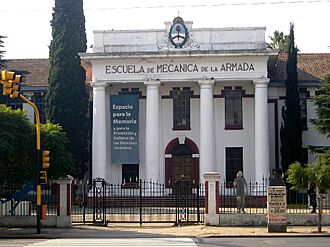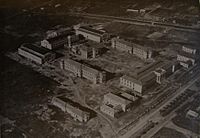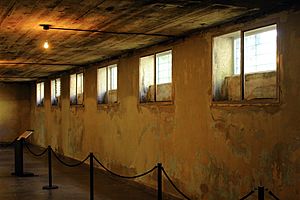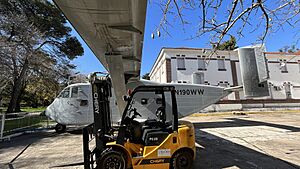Navy Petty-Officers School facts for kids
Quick facts for kids Navy School of Mechanics |
|
|---|---|
|
Escuela de Mecánica de la Armada
|
|
 |
|
| Former names | Escuela Superior de Mecánica de la Armada |
| General information | |
| Location | Núñez, Buenos Aires |
| Country | Argentina |
| Official name | ESMA Museum and Site of Memory – Former Clandestine Center of Detention, Torture and Extermination |
| Type | Cultural |
| Criteria | vi |
| Designated | 2023 (45th session) |
| Reference no. | 1681 |
The Higher School of Mechanics of the Navy (Spanish: Escuela Superior de Mecánica de la Armada, commonly referred to by its acronym ESMA) has gone through three major transformations throughout its history. Originally ESMA served as an educational facility of the Argentine Navy. The original ESMA was a complex located at 8151 Libertador Avenue, in the Autonomous City of Buenos Aires, in the barrio of Núñez. Additionally, It was the seat of U.T.3.3.2—Unidad de Tareas (Task Unit) 2 of G.T.3.3 [es].
However, ESMA operated as an illegal, secret detention center for opponents of the 1976–1983 military dictatorship, described as "subversives" during what was described as the Dirty War. The military took the babies born to mothers imprisoned there, suppressed their true identities, and allowed military families and associates of the regime to illegally adopt them. The Unidad de Tareas (Task Unit) was responsible for thousands of instances of forced disappearance, torture, and murder during this time. ESMA was the largest detention center of its kind during the Dirty War.
The ESMA building has been converted into a memorial museum to show and honor those who were "disappeared" during Argentina's Dirty War. The National Congress passed a law on 5 August 2004 that converted the ESMA complex into a museum, the Space for Memory and for the Promotion and Defense of Human Rights (Espacio para la Memoria y para la Promoción y Defensa de los Derechos Humanos). On 10 June 2014 the Museo Malvinas was inaugurated in the ESMA campus, a museum about the islands disputed and fought over by the United Kingdom (calling them Falkland Islands) and Argentina (Islas Malvinas).
The School, once again legitimate, was renamed Escuela de Suboficiales de la Armada (ESSA; English: Navy Petty-Officers' School) in 2001, and moved in 2005 to the Puerto Belgrano Naval Base, 28 km from the city of Bahía Blanca, and about 600 km southwest of Buenos Aires.
The site was designated a UNESCO World Heritage Site in 2023 under the name 'ESMA Museum and Site of Memory – Former Clandestine Center of Detention, Torture and Extermination'.
Contents
History
Functions and authorities
Legitimate
According to the ESSA Web site, in 1897 the Escuela de Aprendices Mecánicos de la Armada (Navy Apprentice Mechanics School) was founded in premises that are now the Historical Naval Museum of Tigre, in Buenos Aires Province. In 1900 the School moved to naval workshops in Dársena Norte; in 1902 it became Escuela de Aprendices Mecánicos y Foguistas (Apprentice Mechanics and Stokers School). Two years later it became Escuela de Mecánicos de la Armada, and in 1911 Escuela de Mecánica de la Armada. In 1928 it moved to its later notorious premises, designed by the architect Raúl J. Álvarez, on Blandengues street (now Avenida del Libertador), between Arroyo Medrano and the extension of Deheza street. Once again a legitimate educational establishment, it was renamed Escuela de suboficiales de la Armada in 2001, and moved to Puerto Belgrano in 2005, merging the NCO schools of the Argentina Marines and the Argentine Naval Aviation in the process into one institution.
Other sources say that the School was founded in 1924, on land granted that year by the Municipality of Buenos Aires to the Ministry of the Navy by a decree that year, during the presidency of Marcelo T. de Alvear. Under the terms of the decree, it was to revert to the city if it ceased to be a military educational establishment. The School of Mechanics, Naval War School, and Officers' Mess were built on the land.
Each year about 10,000 youths signed up to enter as regular students, of whom around half were admitted and given scholarships for courses of study such as electronics, aeronautics, management, marine engineering (mecánico naval), radio operation, meteorology, and oceanography. The students lived in the complex from Monday through Friday, taking 8 to 10 hours of classes per day. The degrees could be completed in up to three years of studies, with the students receiving the degree of técnico ("technician"), with the option of continuing either as naval servicemen, professional army, or air force NCOs or working elsewhere either in the public or private sector.
The main entrance opens onto the central pavilion, where the authorities' offices were located. A covered patio there was used to show movies to the student body. To the left of this building was petty officers' housing, and further off and separated, the officers' housing, where the clandestine detention center operated during the 1976-1983 military dictatorship. To the right of the central pavilion were the checkpoint, the military guard building, and the Naval War School (Escuela de Guerra Naval).
Behind, at the rear, were the dormitories and, across Avenida Lugones, the institution's sports field. On the perimeter of the school were checkpoints which were manned by the students in rotating shifts, at least one week per year for each student.
In 1982, 230 final-year students of the ESMA were drafted to fight in the Falklands War; some of them died in the sinking of the ARA Belgrano and the attack on ARA Sobral.
In 1998, president Carlos Menem ordered the move of the School to the Puerto Belgrano base, and the use of the old campus as a museum. It was granted the name ESSA in 1999 as the by now sole NCO school of the Navy and continues to function in the Puerto Belgrano base.
Etymology and usage during the Dirty War
Almost 5,000 people were abducted and held in the original ESMA campus in its active participation in the Dirty War between 1976-1983; all except 150 were killed during or after interrogation.
Extrajudicial detention center
The ESMA was used as a detention center from the very start of the 1976 dictatorship: on 24 March, the day of the coup d'état, several people kidnapped by the Armed Forces were taken there.
Task Unit 3.2.2 was led by Rear-Admiral Rubén Jacinto Chamorro and Captain Carlos Acosta Ambone. Jorge Vildoza has been identified by survivors as the second-in-command of ESMA. Among the Task Unit's ranks were Jorge Eduardo Acosta, Alfredo Astiz, Ricardo Miguel Cavallo and Adolfo Scilingo, who became notorious as torturers. Its chaplain during 1977 was Father Alberto Ángel Zanchetta. It was in charge of the city of Buenos Aires proper and the northern part of the metropolitan area (Gran Buenos Aires). Officers in charge were under strict orders not to reveal their identities or military affiliation when capturing prisoners.
Between 1976 and 1978, the group was ultimately under the orders of Navy Commander-in-Chief Emilio Eduardo Massera. Massera had reportedly been present when the unit was set up, gave an opening speech to the officers, and personally participated in the first illegal detentions.
Who became los desaparecidos/the disappeared?
There were certain types of individuals within Argentinian society who were to be kidnapped and removed from it. Stories show, for example, that there was a disproportionate number of Jews taken in custody, shedding light on anti-Semitic victimization. Another group targeted included the people who potentially supported a different government, opposing the current junta and military dictatorship of Argentina. If there was any suspicion that Argentinians were meeting secretly and consistently to resist General Jorge Rafael Videla and his regime, the government would kidnap these people and place them in detention centers such as the ESMA. This would serve as a lesson to incite fear within other members of the community who were also against the current governmental structure of Argentina. Upon being kidnapped, for example, many kidnappers would interrogate the prisoners about why they were opposing the Argentinian dictatorship and spreading a new political ideology, disregarding the fact of whether or not this was actually the case.
Survivor stories of the ESMA
A few victims that survived and escaped the ESMA have made it a priority to share their experiences of the torture and human rights infractions they faced while living in this center.
Trials
A major trial, nicknamed "the ESMA mega-trial", of 63 people accused of crimes against humanity (lesa humanidad) during the 1976-1983 dictatorship was reaching its close in July 2015. 830 witnesses and 789 victims were heard. There had been two previous trials after the Supreme Court struck down an amnesty the military dictatorship had granted its members; in a 2009 trial, twelve defendants were sentenced to life imprisonment. The trial was still in progress as of April 2016[update], and was being covered in a dedicated blog, Causa ESMA, with links to video reports of significant court sentences and similar events; many items are selected from the Argentine Infojus Noticias (National Agency of judicial news) Web site, Nacionales section.
Gonzalo "Chispa" Sánchez was extradited to Argentina and faced charges, as of 2020.
A federal court sentenced eight sailors and police officers and a civilian in the trial of crimes against humanity perpetrated during the military dictatorship at the ESMA on February 19, 2021. Among those convicted are former Navy officer Carlos Castellvi, police officer Raúl Cabral, and civilian Miguel Conde.
Military testimonies
Members of the military claim that they were simply obeying orders. It was also claimed that military members were made to believe they were fighting a war against enemies in civilian clothes. Military members never protested their orders despite being aware of the gruesome acts occurring in the ESMA because they were persuaded to believe that it was a supreme act that needed to be done for the sake of Argentina.
Memorial Museum "Espacio Memoria y Derechos Humanos" (Former ESMA)
Since 2004 the original ESMA building has been used as a memorial museum to honor the memory of the disappeared. However, the mission of the memorial museum goes beyond that. ESMA will serve as a warning to assure that the gruesome acts of torture and other crimes done by the dictatorship will never occur ever again. Argentines feel obligated to use the museum to share the stories of those that lost their lives during the Dirty War and to show the horrors that occurred within the walls of ESMA.
See also
 In Spanish: Escuela de Mecánica de la Armada para niños
In Spanish: Escuela de Mecánica de la Armada para niños
- Pozo de Banfield






